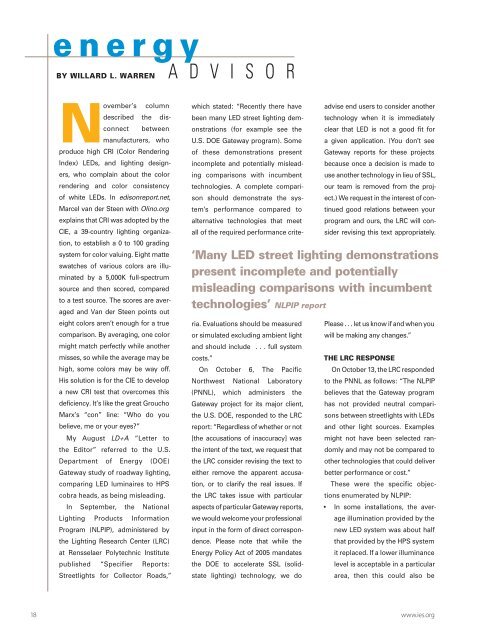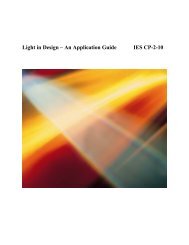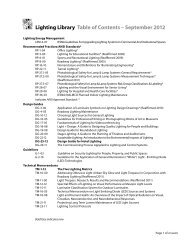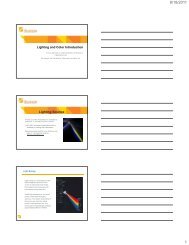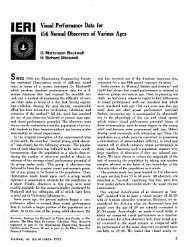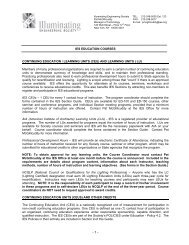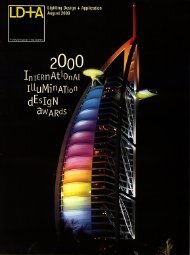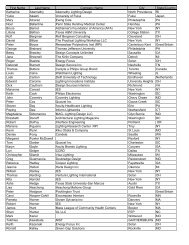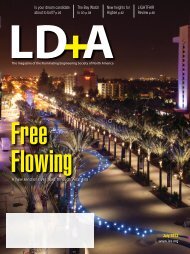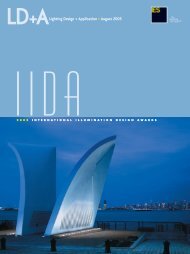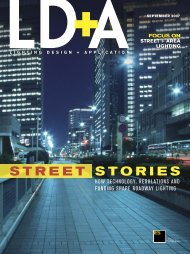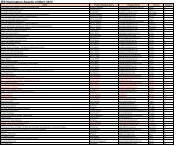faces of the future - Illuminating Engineering Society
faces of the future - Illuminating Engineering Society
faces of the future - Illuminating Engineering Society
You also want an ePaper? Increase the reach of your titles
YUMPU automatically turns print PDFs into web optimized ePapers that Google loves.
energy<br />
BY WILLARD L. WARREN A D V I S O R<br />
November’s column<br />
described <strong>the</strong> disconnect<br />
between<br />
manufacturers, who<br />
produce high CRI (Color Rendering<br />
Index) LEDs, and lighting designers,<br />
who complain about <strong>the</strong> color<br />
rendering and color consistency<br />
<strong>of</strong> white LEDs. In edisonreport.net,<br />
Marcel van der Steen with Olino.org<br />
explains that CRI was adopted by <strong>the</strong><br />
CIE, a 39-country lighting organization,<br />
to establish a 0 to 100 grading<br />
system for color valuing. Eight matte<br />
swatches <strong>of</strong> various colors are illuminated<br />
by a 5,000K full-spectrum<br />
source and <strong>the</strong>n scored, compared<br />
to a test source. The scores are averaged<br />
and Van der Steen points out<br />
eight colors aren’t enough for a true<br />
comparison. By averaging, one color<br />
might match perfectly while ano<strong>the</strong>r<br />
misses, so while <strong>the</strong> average may be<br />
high, some colors may be way <strong>of</strong>f.<br />
His solution is for <strong>the</strong> CIE to develop<br />
a new CRI test that overcomes this<br />
deficiency. It’s like <strong>the</strong> great Groucho<br />
Marx’s “con” line: “Who do you<br />
believe, me or your eyes”<br />
My August LD+A “Letter to<br />
<strong>the</strong> Editor” referred to <strong>the</strong> U.S.<br />
Department <strong>of</strong> Energy (DOE)<br />
Gateway study <strong>of</strong> roadway lighting,<br />
comparing LED luminaires to HPS<br />
cobra heads, as being misleading.<br />
In September, <strong>the</strong> National<br />
Lighting Products Information<br />
Program (NLPIP), administered by<br />
<strong>the</strong> Lighting Research Center (LRC)<br />
at Rensselaer Polytechnic Institute<br />
published “Specifier Reports:<br />
Streetlights for Collector Roads,”<br />
which stated: “Recently <strong>the</strong>re have<br />
been many LED street lighting demonstrations<br />
(for example see <strong>the</strong><br />
U.S. DOE Gateway program). Some<br />
<strong>of</strong> <strong>the</strong>se demonstrations present<br />
incomplete and potentially misleading<br />
comparisons with incumbent<br />
technologies. A complete comparison<br />
should demonstrate <strong>the</strong> system’s<br />
performance compared to<br />
alternative technologies that meet<br />
all <strong>of</strong> <strong>the</strong> required performance criteria.<br />
Evaluations should be measured<br />
or simulated excluding ambient light<br />
and should include . . . full system<br />
costs.”<br />
On October 6, The Pacific<br />
Northwest National Laboratory<br />
(PNNL), which administers <strong>the</strong><br />
Gateway project for its major client,<br />
<strong>the</strong> U.S. DOE, responded to <strong>the</strong> LRC<br />
report: “Regardless <strong>of</strong> whe<strong>the</strong>r or not<br />
[<strong>the</strong> accusations <strong>of</strong> inaccuracy] was<br />
<strong>the</strong> intent <strong>of</strong> <strong>the</strong> text, we request that<br />
<strong>the</strong> LRC consider revising <strong>the</strong> text to<br />
ei<strong>the</strong>r remove <strong>the</strong> apparent accusation,<br />
or to clarify <strong>the</strong> real issues. If<br />
<strong>the</strong> LRC takes issue with particular<br />
aspects <strong>of</strong> particular Gateway reports,<br />
we would welcome your pr<strong>of</strong>essional<br />
input in <strong>the</strong> form <strong>of</strong> direct correspondence.<br />
Please note that while <strong>the</strong><br />
Energy Policy Act <strong>of</strong> 2005 mandates<br />
<strong>the</strong> DOE to accelerate SSL (solidstate<br />
lighting) technology, we do<br />
advise end users to consider ano<strong>the</strong>r<br />
technology when it is immediately<br />
clear that LED is not a good fit for<br />
a given application. (You don’t see<br />
Gateway reports for <strong>the</strong>se projects<br />
because once a decision is made to<br />
use ano<strong>the</strong>r technology in lieu <strong>of</strong> SSL,<br />
our team is removed from <strong>the</strong> project.)<br />
We request in <strong>the</strong> interest <strong>of</strong> continued<br />
good relations between your<br />
program and ours, <strong>the</strong> LRC will consider<br />
revising this text appropriately.<br />
‘Many LED street lighting demonstrations<br />
present incomplete and potentially<br />
misleading comparisons with incumbent<br />
technologies’ NLPIP report<br />
Please . . . let us know if and when you<br />
will be making any changes.”<br />
THE LRC RESPONSE<br />
On October 13, <strong>the</strong> LRC responded<br />
to <strong>the</strong> PNNL as follows: “The NLPIP<br />
believes that <strong>the</strong> Gateway program<br />
has not provided neutral comparisons<br />
between streetlights with LEDs<br />
and o<strong>the</strong>r light sources. Examples<br />
might not have been selected randomly<br />
and may not be compared to<br />
o<strong>the</strong>r technologies that could deliver<br />
better performance or cost.”<br />
These were <strong>the</strong> specific objections<br />
enumerated by NLPIP:<br />
• In some installations, <strong>the</strong> average<br />
illumination provided by <strong>the</strong><br />
new LED system was about half<br />
that provided by <strong>the</strong> HPS system<br />
it replaced. If a lower illuminance<br />
level is acceptable in a particular<br />
area, <strong>the</strong>n this could also be<br />
18 www.ies.org


